A leaked ETECSA presentation on home Internet connectivity in Cuba
I don't criticize to knock the system down. On the contrary, I criticize to perfect the system.
Carlos Alberto Pérez
This post has taken several twists and turns.
I started out to write a post commenting on an ETECSA PowerPoint presentation on their plan for home Internet connectivity. The presentation had been leaked by Carlos Alberto Pérez on his blog Chiringa de Cuba on June 23. In addition to some analysis of the plan, I was going to discuss the role of Chinese equipment suppliers, predominantly Huawei.
Then, on June 25, ETECSA denied the validity of the leaked document, saying it was used only for training. They said the tentative prices shown were incorrect, but did not retract the substance of the presentation, which shows a plan to provide DSL service to some Cuban homes using Chinese equipment.
That denial was followed by the blocking of access to Pérez' blog, presumably because he had published the leaked document.
You can no longer access Pérez' post, but the presentation itself has been posted by several people. I have put a copy here, and invite people to add comments to it. (As they say, information wants to be free).
I will provide my reactions to the leaked document here and save the reflections on the Chinese role for a second post.
The presentation says ETECSA plans to roll out asymmetric (faster download than upload) DSL service using Chinese equipment in an unspecified number of central offices. As we see in the following leaked slide, they will use Huawei ME 60 gateways between the phone and IP networks and have ordered 15,000 TP Link TD 8840T modems for homes. I do not know, but it seems reasonable to guess that the digital multiplexers (DSLAMs) installed in the central offices will be from Huawei as well. (I'll get to the question marks later).
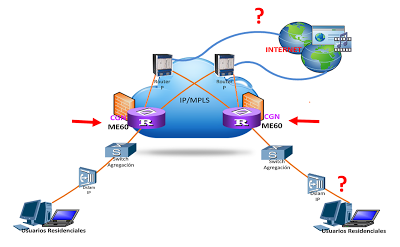
The following price slide was included in the presentation, but ETECSA has said this was only a place-holder for training purposes and I will take them at their word -- consider these prices only as possibilities:
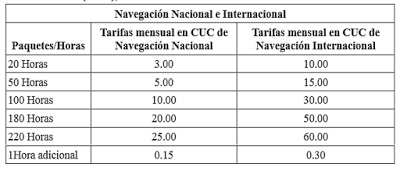
These prices may be higher than we eventually see, but there will surely be a significant number of people who cannot afford a DSL connection so we can imagine people sharing accounts and a black market for reselling time.
The following slide differentiates between national and international access, so I presume that the actual prices will take that into account. That would be reasonable since most international access will be over congested satellite links. The slides say nothing about which, if any, international sites will be blocked.
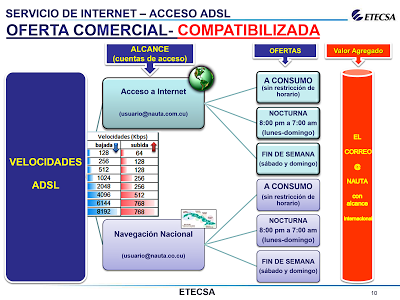
The above slide also differentiates speed levels, times of day and days of the week. I suspect the actual pricing will take time and day into account, but that may or may not be the case for the different speeds that are shown. Varying infrastructure will cause speed differences regardless of price.
Before a home can receive DSL service, the equipment in the central office serving it must be upgraded and a relatively short, high quality phone line must run between the home and its central office. (That is one of the question marks in previous diagram).
Cuba reported 3,882,424 private homes (2012) and 939,500 residential phone lines. That means around 2.9 million homes would have to be wired before they could have Internet service. The presentation says they will give priority to homes that already have land lines and those belonging to the self-employed. (The former is obvious and the latter interesting).
Cuba reports having 688 central offices (2013), few of which contain DSL equipment. Most would have to be upgraded in order to provide DSL service.
Once connected, what will be the data transmission speed? The above slide shows asymmetric (down/up) connection speeds ranging from 128/64 to 8,192/768 kb/s. With DSL technology, transmission speed depends upon the distance of a home from its central office and the condition of the copper lines connecting them. These are always best effort numbers -- "up to" the stated speeds.
Let me give an example, I live Los Angeles and Google Maps says I am 1.1 mile from my central office. Verizon offers me two service levels: "high speed" DSL service is .5-1 mb/s and "enhanced" service is from 1.5-3 mb/s, for an extra $10 per month. To be fair, the copper in my neighborhood is 70 years old, but I doubt that many Cuban customers will be able to get 8,192 kb/s.
There is also a slide showing day/night and weekday/weekend traffic patterns. Judging from the y-axis, I am guessing that this is showing international traffic, which is heavy during week days. Before a user logs on, he or she will be able to measure their current connection speed before starting a session and using their hours.
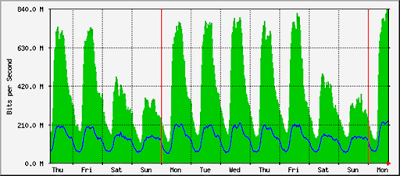
The Internet connection is the second question mark in the previous diagram. What are the connection speeds between the central offices and the Internet? In the US, central offices are connected by high speed fiber, but I know little about Cuba. For example, in Havana, some or all central offices may be connected to a fiber backbone, but what of the link from there to the Internet? Havana is far from the undersea cable landing to the east, so I imagine those links are via congested satellites.
The bottom line is that this is an early step toward modern home connectivity using yesterday's technology and I hope Cubans are planning to leapfrog today's technology in the long run.
Well, that is a little tea reading from the leaked slides. It is too bad that the situation is so opaque that we have to guess about ETECSA and their plans and it is even worse that they seem to have blocked Pérez' blog. He is an asset, not a threat -- as he has stated "I don't criticize to knock the system down. On the contrary, I criticize to perfect the system."
I think the involvement of Chinese suppliers is more interesting than this leak, and I will take that up in a subsequent post.
-----
Update 6/29/3025
Ted Henken told me that the problem with accessing Chiringadecuba.com may not have been government blocking but expiration of the domain name, and it seems he was correct.
I did a whois lookup and it turns out the domain expiration date was 2015-06-26. I then checked at the registrar, Name.com, and saw that chiringadecuba.com is not available. It sounds like it may have expired, but they are giving Perez a grace period within which to re-activate it. Since he would not have a US credit card, there may be some difficulty with that.
-----
Update 6/29/2015
Chiringadecuba.com is online again and the expiration date has been extended till next year. My apologies to ETECSA for fearing that they may have blocked access.
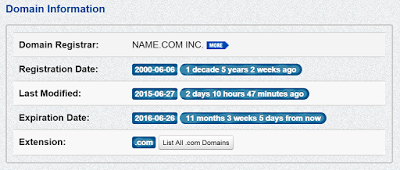
-----
Update 1/27/2016
Huawei has tested their new technology, g.fast, in Panama. The technology trial ran for two months and they achieved speeds averaging 500 Mbps to download and 150 Mbps to upload, over existing copper lines.
I wonder if that is the technology they will be deploying in Cuba and how it will perform over Cuban infrastructure.
-----
Update 2/1/2016
ETECSA has announced a pilot home connectivity project in two Havana neighborhoods. The Associated Press report says Cubans in Old Havana will be able to "order service through fiber optic connections operated with Chinese telecom operator Huawei."
I would be surprised if they are talking about fiber to the premises -- hybrid fiber/copper is more likely. They also said they would being allowing cafes, bars and restaurants to begin ordering broadband service. No dates or prices were given.
I have also heard from a reader that some casas particulares are offering Internet connectivity in Havana, but I do not know how they are connected or at what speed and cost.
-----
Update 2/11/2016
The anti-Castro Internet advocacy group Foundation for Human Rights in Cuba has released a post suggesting that the choice of Huawei for the home-access pilot in Old Havana was motivated by Huawei's expertise in censorship and surveillance.
This Old Havana pilot deployment is quite limited, but Huawei is also the equipment vendor for forthcoming DSL home connectivity and Cuba's WiFi hotpots.
While the embargo was in effect, Huawei was a logical choice for Internet infrastructure in Cuba, but today, the embargo is not keeping the Cubans from considering offers from US and other competitors. Huawei's experience with and openness to censorship and surveillance may indeed offer them a competitive advantage in Cuba.
-----
Update 2/13/2016
I mentioned the assertion by The Foundation for Human Rights that experience with and an openness to surveillance and censorship gave Huawei a competitive advantage against US infrastructure providers to Doug Madory, but he disagreed, saying:
No not really. There are plenty of companies that offer products that can be used for surveillance and censorship -- see the usage of Blue Coat of Canada in Syria. Huawei is both inexpensive and not western. Those are probably bigger reasons.
At The Economist event (last December) I spoke with the country manager (of a US firm) for Cuba and he said he was in the room for one of the main presentations from Hauwei to ETECSA. He said Hauwei had brought a dozen engineers and had put a lot of work into their proposal for a telecom build-out. Hauwei wanted this deal very much.
- Year End Interview Of The President Of Etecsa
"The people want to be connected." ETECSA president, ingeniera Mayra Arevich Marín Maya Arevich Marín has been president of ETECSA for four years. The following are a few points from a recent year-end interview. Internet access was improved through...
- Cuban Infrastructure Investment -- China Won The First Round
China won the first round, what about the future? In December 2014, the administration announced that we were taking "historic steps to chart a new course in our relations with Cuba and to further engage and empower the Cuban people." The following month,...
- Speculation On The Cuban Internet Backbone
Since the earliest days of the Internet, Cuba has stressed geographically distributed connectivity, unlike most developing nations, which focused on one or a few large cities. That policy is still in effect. There are plans to connect universities, schools...
- Cuba Connecting Universities With Fiber
Is this the start of a fiber backbone? Walter Baluja, Director of the Computer Science Department of the Ministry of Higher Education has announced that starting January of 2016 all academic centers in the country will have access to fiber connections....
- What Is The Effect U.s. Trade Restrictions On It Exports To Cuba?
The Senate Finance Committee is researching the economic impact of U.S. embargo on trade with Cuba and I was asked to testify before the US International Trade Commission on the effects of the U.S. restrictions on our exports of telecommunication equipment...
